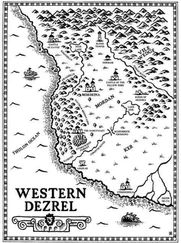1815, or the return of the previous century: in Paris first, but also in Naples where Joachim Murat, king of Italy and brother-in-law of the “Ogre,” has just been shot by firing squad.
In Naples where, as it happens, Countess Adelaide was feeling all alone: Adelaide, wife of Count Borgia, never leaves her dwelling, a veritable museum, the palace of the Borgia family. Her husband, Camille Borgia, the forty-one-year-old son of General Giovanni Paolo Borgia and the nephew of Cardinal Stefano Borgia, has had to choose exile as a precautionary measure, because in his youthful ardor as a sympathizer with the “revolutionaries” of earlier years he had enlisted in Murat’s army as an officer. Then, rather rapidly, he had been promoted to the rank of general.
Having been born in a museum , Camille Borgia wrote, he had, so to speak, suckled a passion for antiquities with his milk . In his current difficulties, he decides to cross the Mediterranean to explore the ruins of Carthage around Tunis — to reflect, among the stones of antiquity, upon the destruction of the empires of this world and finally to fulfill what he believes to be his true vocation, becoming an archeologist.
As 1815 comes to an end and throughout 1816, Countess Adelaide will do her best to make something of her forced solitude. She regularly invites her circle of friends to the ancestral palace to read the chronicle that the count regularly sends her of his “scientific travels.” Had Borgia “fled” to the land of the Moors? No, this was rather more of a stroll, drawing pencil in hand, with a mind inclined to wax philosophical in the midst of ruins, in search of monuments, some of which had been standing intact or nearly so for more than twenty centuries …
And this is how the renegade Neapolitan count will end up following in the footsteps of the Provençal slave of earlier times, Thomas-Osmann d’Arcos!
The count arrives in Tunis on 19 August 1815, carrying a Danish passport: He did in fact have the title of king’s chamberlain in Denmark. Welcomed by the Danish consul in Tunis he is introduced to the bey’s ministers and the diplomatic circle … He sets himself up in the Imperial, the only hotel in the capital with European amenities, and at the same time immediately begins his first archeological tours in the countryside around Tunis. He becomes the friend of a Dutch engineer, J. E. Humbert, who is an officer in the corps of engineers sent there long before and on good terms with several dignitaries serving the Tunisian sovereign.
In December 1815 Count Borgia and Humbert decide to make an excursion to study the origins of the aqueduct of Carthage in the Zaghouan plateau. Together they make discoveries that escaped several travelers and explorers of the previous century (Peysonnel, Shaw, Bruce, and so on). Not long after, when his Dutch friend manages to join the entourage of Mohammed Khodja, one of the bey’s ministers, Count Borgia undertakes a journey to Le Kef with them. On their return he stops and spends four days in Dougga.
Was he, like the Provençal slave before him, struck with passionate amazement so that he spent his days there drawing everything in sight? As soon as he is back in Tunis, he writes a long letter describing everything he saw, specifically the strange three-story mausoleum. While there, he made numerous pencil sketches, some of which he later traces over with ink. He methodically reproduces each of the monument’s façades as well as numerous plans of the inner chambers on all three levels. Finally, he copies down the bilingual inscription — in the notes he wrote in Italian to accompany the reproduction he mentions two types of lettering, mistakenly referring to them as punico e punico-ispanico .
Thus it is not the mystery of the unknown writing that strikes him, although he senses something strange about the cenotaph, which he attributes to its architectural style, a mixture of Hellenistic inspiration and oriental archaism. He reproduces the Ionic columns with their capitals whose volutes are in the shape of lotus blossoms, and on each level the horizontal stone layer with the architrave and an Egyptian neck. He asks himself questions about the funerary functions of the whole: Had there been small funeral urns in the empty niches of the inner chambers?
Borgia spends all of 1816 exploring other sites in coastal and northern Tunisia; his accounts are regularly sent to the countess, where they are read to a circle of scholars and enthusiasts. In Naples, Borgia the military man is forgotten in favor of Borgia the archeologist. He finally returns to his country in January 1817 with the intention of publishing as quickly as possible the chronicle of his wonderful journey that so inspired him. A well-known engraver is already at work on a series of plates based on Borgia’s wash drawings; among them is an engraving of the Libyco-Punic mausoleum of Dougga.
Alas, Borgia dies suddenly at the end of 1817. His widow assembles all his papers, the Borgiana (harvest of her husband’s travels), and sells them to a French enthusiast, who promises to publish them quickly, but he in turn sells them to the national museum in Leyden, which also acquires Humbert’s papers. This entire unpublished body of work will remain dormant, unpublished, until … 1959.
Meanwhile, in a scholarly review in 1867 the traveler’s son will lament the fact that the Dutch government did not keep its promise to make known his father’s work. Meanwhile, luckily, several scholars will go to copy from this voluminous file at least the mysterious writing of the bilingual inscription of Dougga.
Years go by after Borgia: The strange alphabet keeps its mystery and the mausoleum stands intact — how long? — in the space and ruins of ex-Thugga.
AT THE BEGINNING of the summer of 1832 in Algiers, the painter Delacroix, returning from a visit to Morocco, stops and spends three days painting at the home of a former raïs . On June 22 he departs once more, carrying in his sketches and in his memory the elements of the composition that several years later will become the masterpiece Women of Algiers in Their Apartment— a lighthouse on the outposts of the colonial darkness represented by Algerian history. Thus placed so suddenly and prominently on display for the public to see, the feminine Algeria will henceforth make itself invisible in its heart of darkness and iridescence for generations to come.
Delacroix left at the end of June, and on July 5 a British lord, Sir Granville Temple, who is a fanatic about archeology, lands in Algiers. Accompanied by his wife, his sister, a couple of English friends, and a young French artist, whose job it is to draw views and landscapes, Lord Temple stays with the English consul, St. John, who had witnessed the capture of Algiers by the French.
They launch into a fashionable social life “with the charming daughters of the duchess of Rovigo,” and they attend the very brilliant ball given by the governor on July 29 (at which the former bey of Médéa appears, dazzling the foreigners with his oriental elegance). Ecstatic over the beauty of the countryside, which he explores from Algiers to Bouzareah, Sir Temple also has time to visit the American consul, discover the city, and note the price of merchandise at the market of Algiers, as well the number of schools (twenty-six Koranic, three Christian, and eight Jewish).
He leaves Algiers to return to the city of Bône, which, on March 28 of that same year, had been conquered by Colonel Yousouf. From there he sets off again by sea and has his presence announced to the English consul in Tunis when he arrives there on August 19.
The consul, Sir Thomas Reade, greets Lord Granville Temple and his family and friends at their boat and accompanies them to La Goulette; from there he takes them to his property at La Marsa. But Granville is dying to do just one thing.
Читать дальше












